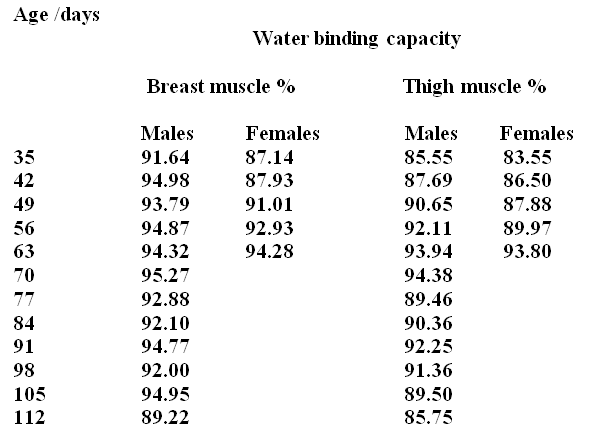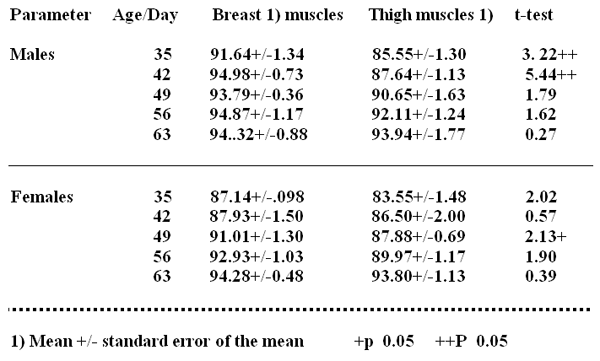Effect of Age, Sex and Live Weight on the Binding Capacity of Broiler Chicks
Published: January 1, 2002
By: Mostafa Elsabbagh (Lebanese university)
To measure the water binding capacity in broiler chicks of both sexes to higher live weights 200 broilers of hybrid combination Ross 208(120 males and 80 females were fattened separately on deep litter with a starter 22%protein/3100Kcal ME to 26 days of age and 20% protein/3200Kcal ME as a finisher to 9 and 16 weeks of age to the females and males respectively. With males was found that the water binding capacity in breast muscles increased gradually from 91.22% (35 days) to 95.27% (70 days) then decreased gradually to 89.22% (112 days). In the thigh muscles also increased from 85.55% (35 days) to 94.38% (70 days) then decreased to 85.75 % at (112 days). With females the binding capacity in the same trend increased in the breast and thigh muscles from 87.55 and 83.55 %( 35 days) to 94.28 and 93.80 %( 70 days). No Significant differences in water binding capacity in breast between both sexes were observed to 63 days of age (49-63 days) and in thigh muscles (35-63 days). In females water binding capacity in breast was significant (P+ 0.05) by 3.13% than the thigh muscle at 49 days of age. From organoleptic point of view the breast was better in both sexes and in males better than females for juiciness, softness, consistency and tenderness.
Review of literature
Since the water binding capacity is expressed by the ability of raw meat to bind water, this capacity seems to be higher in poultry meat (Brendl 1970), since the water content in muscles plays an important role not only in technologies of meat processing but also in the muscle stability and organoleptic characters like juiciness, softness, consistency and tenderness. Nadera et al (1970) found that the highest binding capacity was in breast then back, neck, thigh drumstick where it was the lowest.Uhrin et al (1986) found that the capacity of water retention differed significantly with different broiler strains at 49 days of age.Veerkamp (1986) found that the shrinkage and yield of processing and cut-up estimated at 36, 43, and 50 days of age was between 0.20 and 0.25 % per hour depending on age.
Materials and Methods
In an experiment with hybrid broiler chickens ROSS 208 (120 males and 80 females) fattened separately according to their sex in pens on a deep litter and fed to ad libtum on starter with 22% protein/ 3100 Kcal ME and finishes with 20% protein /3200 Kcal ME to the end of the experiment .The water binding capacity of the muscles was determined by cutting vertically into pieces of 1-2 grams weight muscle samples. These pieces were pressed on filter paper between two glasses for 5 minutes by using a weight of 500 grams placed on the upper glass. The loading pressing time was observed. Muscle samples were weighed before and after pressing and also the filter paper was weighed to determine the water binding portion as a percentage of the total water quantity in the muscle sample according to relation
Where:
X= weight of sample before pressing
Y = after
RESULTS AND DISCUSSION:
Changes in the water binding capacity in breast and thigh muscles of male and female chicks in relation to age and sex are shown in table (1).
Table (1): Dynamics of the water binding capacity in breast and thigh muscles in relation to sex and age

With male chicks, the water binding capacity in breast muscle increased gradually from 91.22% (35 days) to 95.27% (70 days) and then gradually decreased to 89.22% at 112 days of age, In thigh muscles, similar trends were observed since there was a gradual increase in the water binding capacity from 85.55 (35 days) to 94.38% (70 days) which then decreased to 85.75 at the end of the experiment.
With females, similar trends were observed in breast and thigh muscles since the water binding capacity increased from 87.14 and 83.55% (35 days) to 94.28 and 93.80% (63 days) in breast and thigh muscles, respectuively.
Significant differences (P 0.05- 0.01) were observed in water binding capacity in breast muscles between male and female chicks as in table (2) the breast muscle of males had a binding capacity higher by 4.50 and 7.05% than females at 35-42 days of age.
No significant differences in the water binding capacity between both sexes were observed in breast muscles (49-63) and (35-63) days in age in thigh muscles.
Table (2): Effect of sex on water binding capacity of breast and thigh muscles at 35-63 days of age

Table (3) shows the water binding capacity in the breast muscles of males was significantly higher (P 0.01_ by 6.09 and 7.37%than in the thigh muscles at 35 and 42 days of age.
In females, the water binding capacity of breast was significantly higher (P+0.05) by 3.13% than in thigh muscles at 49 days of age.
Table (3): Differences in water binding capacity between breast and thigh muscles of the same sex at 35-63 days of age:

The significance in water binding capacity between the breast and thigh muscles was due to the fact that breast muscles are white muscles with low fat content and high moisture ,while thigh muscles are red muscles of high fat content and low moisture.
The other reason is the normal pH values at 2 and 24 hours after slaughtering which increases the water binding capacity in the muscles.
Similar observations were made by Nadera et (1970) and others.
From the organoleptic point of view, the breast muscles of both sexes were the best and they were better in male chicks than females for juiciness, softness, consistency and tenderness due to the higher quantity of water than in thigh The dependence of the water binding capacity (%) in breast and thigh (Y) muscles on age and on live weight of chicks(X) was expressed by linear and non-linear equations as shown in table (4)
Table (4) Dependence of the water binding capacity (%) in breast and thigh muscles on age and live weight of chicks – regression equations

CONCLUSION:
In the experiment we try to define the optimal time of ending fattening with regard to its effectiveness on the quality of meat and its nutritional value of the final products. No significant differences in water binding capacity between both sexes in breast (49-63) and (35-63) days of age in the thigh. were observed.
Differences on water binding capacity between the breast and the thigh due to their chemical composition. Normal pH values at 2 and 24 hours after slaughtering increase the water binding capacity. From the organoleptic point of view the breast muscles of both sexes were the best and they were better in males than females for juiciness, softness, consistency and tenderness. Than the thigh ones.
REFERENCES:
1-BRENDEL, J.: VAznost masa. pp.3-170, 1970
2-FROMM, D.-MONROE, K.V.:-Moisture absorption and retention of fleshing eviscerated broilers as influenced by holding time in Slush ice.Poult.Sci.73: 328-330.1995.
3-NADERA, D.N,: Biochemistry of avian meat, hydration.I-Comparision of various species.Poult.Sci.49:1335, 1970
4-NADERA, D.N.: Biochemistry of avian meat, hydration II-Factors affecting the hydration of broiler meat .Poult.Sci 49:1446, 1970
5-SCHERMERHORN, E.P.-STADELMAN, W.J.: Effects of polyphosphates on water uptake, moisture retention and cooking loss in broilers .Poult.Sci.41:1680, 1972
6-UHRIN, V.-HORVATHOVA, N.-LAGIN, L.: A kostne ukazovatele vykrmovej hydiny a jej nutricna hodnota. Zbor.zo. seminara intenzifikacne factory vyroby hydinove masa, 1985, pp.105-120
Related topics
Authors:
Join to be able to comment.
Once you join Engormix, you will be able to participate in all content and forums.
* Required information
Would you like to discuss another topic? Create a new post to engage with experts in the community.
Create a post







.jpg&w=3840&q=75)